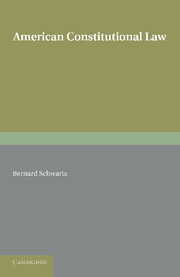Book contents
- Frontmatter
- Dedication
- Contents
- Foreword
- Preface
- PART I THE STRUCTURE
- PART II MODERN DEVELOPMENTS
- Chapter VI The New Federalism
- Chapter VII Presidential Prerogative and the Steel Seizure Case
- Chapter VIII The Changing Role of the Supreme Court
- Chapter IX The Negro and the Law
- Chapter X Civil Liberties and the 'Cold War
- Chapter XI Administrative Law
- Chapter XII The United States and the United Nations
- Appendix: Constitution of the United States of America
- Index of Cases
- General Index
Chapter VI - The New Federalism
from PART II - MODERN DEVELOPMENTS
Published online by Cambridge University Press: 05 June 2016
- Frontmatter
- Dedication
- Contents
- Foreword
- Preface
- PART I THE STRUCTURE
- PART II MODERN DEVELOPMENTS
- Chapter VI The New Federalism
- Chapter VII Presidential Prerogative and the Steel Seizure Case
- Chapter VIII The Changing Role of the Supreme Court
- Chapter IX The Negro and the Law
- Chapter X Civil Liberties and the 'Cold War
- Chapter XI Administrative Law
- Chapter XII The United States and the United Nations
- Appendix: Constitution of the United States of America
- Index of Cases
- General Index
Summary
‘What is the fundamental characteristic of the United States considered as an association of states?’ asks the leading English study of federal government. The answer, according to the author, is the principle under which the general and the regional governments are co-ordinate and independent in their respective spheres. ‘The answer seems to be that the Constitution of the United States establishes an association of states so organized that powers are divided between a general government which in certain matters…is independent of the governments of the associated states, and, on the other hand, state governments which in certain matters are, in their turn, independent of the general government.’
There is little doubt but that this answer accords with the structure of the American Union that was contemplated by the framers of the Federal Constitution. Their dominant concern was to ensure that the national Government which they were creating would not be so powerful that it would, in practice, swallow up the States out of which the nation was to be composed. They sought to accomplish this by limiting the Federal Government to a specific list of enumerated powers which were essential to its effective functioning, while reserving all other authority to the States, which were to continue unaltered as separate sovereignties, except for whatever powers they had surrendered to the nation. The concept of federalism which pervaded the governmental philosophy of the founders of the American Union was based upon the co-ordinate and independent position of the different centres of government. What was necessary, in their view, was that each government should be limited to its own sphere and, within that sphere, should be independent of the other.
‘In the classical Anglo-American doctrine of federalism,’ a French student of American public law has declared, ‘the division of powers between the federal State and the member-States guarantees, to the one and to the others, full sovereignty in the domain appropriate to each. The exercise of federal powers should not infringe upon the area of powers reserved to the member-States. And vice versa.’ This classical concept of federalism, however, upon which the American system was based, has not been able successfully to withstand the stresses of twentieth-century political evolution.
- Type
- Chapter
- Information
- American Constitutional Law , pp. 163 - 186Publisher: Cambridge University PressPrint publication year: 2013

